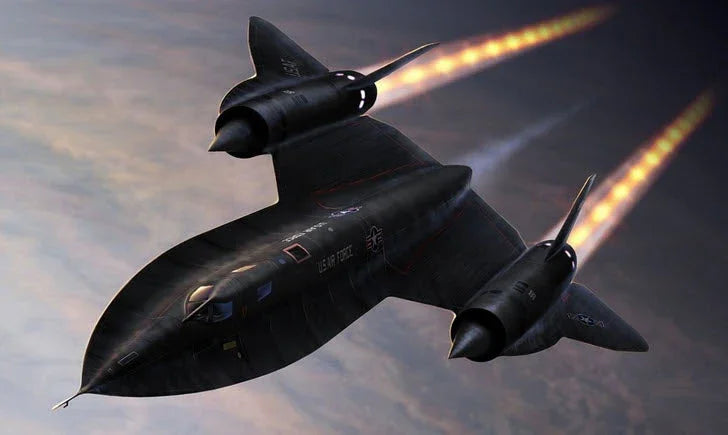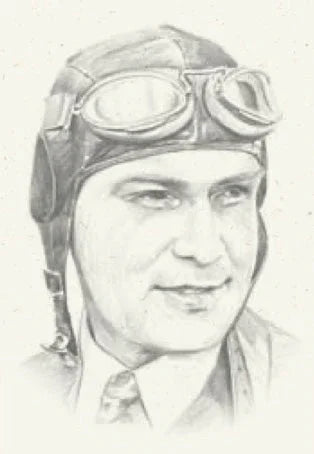The "Skunk Works"
Who Do You Call?
During World War II there were a number of aircraft manufacturers who were designing, testing, and manufacturing new aircraft on a regular basis.
Some of the most famous aircraft built were the North American P-51D Mustang, the Grumman F4F Wildcat, the Douglas SBD-6 Dauntless, and the Curtis P-40E Warhawk.
These incredible aircraft were designed and manufactured by such great American companies as Boeing, Curtiss Aircraft, Gruman Aircraft, Lockheed Aircraft, Martin Aircraft, North American Aviation, and Douglas Aircraft.
Most all of these companies had been designing larger civil aircraft in the prewar years.
During the war, all of these companies worked extremely hard to help Americans (and the allies) win the war.
Clarence Leonard "Kelly" Johnson
Clarence Leonard Johnson was born on February 27, 1910, in the remote town of Ishpeming, Michigan, where his father ran a construction company.
He was fascinated by the new flying machines, and when he was just 13 years old he won a prize for his first aircraft design!
But life was not always fun for young Clarence, whom his fellow grade school students decided to call "Clara". One morning, while waiting in line for school, one of his classmates started calling him "Clara".
By this time Clarance was frustrated and tripped this kid so hard that the kid broke his leg!
From that time forward his classmates started calling him "Kelly", named after a nickname in the song of the time called "Has Anyone Here Seen Kelly?"
The nickname stuck.
After graduating from high school Kelly went to Flint Junior College, followed by the University of Michigan.
At the University of Michigan, Kelly helped conduct wind tunnel tests of Lockheed's Model 10 airliner.
Kelly then went on to graduate with a Master's Degree in Aeronautical Engineering from the University of Michigan.
Upon completion of his master's degree in 1933, Kelly Johnson joined Lockheed as a tool designer, and shortly after starting there he convinced Lockheed that the Model 10 airliner was unstable.
Lockheed sent Kelly Johnson back to the U of M where he made a lot of changes to the wind tunnel model, including adding an "H" tail to the aircraft.
Lockheed agreed with him, and the Model 10 went on to be a success.
That brought young Kelly Johnson to the attention of Lockheed management, and soon he was promoted to an aeronautical engineer in the company.
The "Skunk Works"
In 1938 Lockheed was asked by Lieutenant Benjamin S. Kelsey of the U.S. Army Air Corp to build a high-speed, high-altitude fighter to compete with German aircraft.
At that time Lockheed had a contract to build Hudson bombers for the British, but a small group of engineers (including Johnson) to fabricate what would become the P-38 Lightning.
Kelly Johnson walled off one section of a building, which was off-limits to all but those involved directly in the project.
Thus, the "Skunk Works" was born.
The name "Skunk Works" is a play off the "Skonk Oil" factory in the popular Li'l Abner newspaper comic strip.
Secretly, a number of advanced innovations were included in the new fighter including a revolutionary way to apply the aluminum skin of the aircraft.
The XP-38 became the first 400 mph fighter in the world!

The Lockheed P-38 Lightning
Next on the agenda in late 1943 was to build a jet fighter around the British Goblin jet engine.
The group developed the XP-80 which later became the P-80 Shooting Star, the first jet fighter flown by the United States Army Air Forces.
But World War II came to an end on September 2nd, 1945.
So, what was next for these incredible engineers?
The Cold War
The Cold War is believed to have started on March 12th, 1947, when the Truman Doctrine was announced, and finally ended with the dissolution of the Soviet Union on December 26, 1991.
The Cold War was punctuated by the testing of nuclear bombs as each country (the USA and the Soviet Union) jockeyed for dominance.
This period created new missions which required solving the most critical national security challenges.
The Call
In 1955 the CIA asked the "Skunk Works" to build a spy plane with the job of flying over the Soviet Union to photograph military sites of strategic interest.
By this time most aircraft manufacturers were looking to build civilian passenger aircraft where they could sell large numbers of them.
Enter Clarence Leonard "Kelly" Johnson.
Kelly Johnson was an aeronautical and systems engineer who was recognized for his contribution to a number of important World War II aircraft designs.
He was the first team leader of Lockheed's "Skunk Works", where he worked for 40 years and was said to have been an organizing genius.
The Aircraft
"Skunk Works" is the official pseudonym for Lockheed Martin's Advanced Aircraft Development Program.
Over the years Lockheed's "Skunk Works" and Kelly Johnson were responsible for the design of some of the most famous high-performance aircraft in the world.
These included the Lockheed U-2 in which Gary Powers was shot down over the Soviet Union.

Kelly Johnson in front of the famous U-2 Spy Plane.
Johnson was convinced that the U-2 would have a limited useful life flying over the Soviet Union, and after almost 4 years of overflights, Francis Gary Powers was shot down in his U-2 while on a mission over Russia.
Johnson and his team had already started on the design of the A-12, but building a Mach 3.0+ aircraft out of titanium posed a lot of problems.
As a result, the first A-12 flight didn't occur until 1962.
Several years later the U.S. Air Force became interested in the design and ordered the SR-71 Blackbird.
Next, Kelly Johnson and his team designed the first fighter aircraft that could fly at Mach 2, and the incredible SR-71, the top speed of which remains classified to this date.

The SR-71 Assembly Line at Lockheed's "Skunk Works"
How successful was the SR-71 Blackbird in its mission?
Consider this - during its history of flights it is estimated that more than 4,000 surface-to-air missiles were fired at it over the decades, and not one SR-71 was ever shot down or even hit!
Sadly, we lost an incredible asset when Clarence Leonard "Kelly" Johnson passed away on December 21, 1990.
The good news however is that the "Skunk Works" continues its incredible work to this day.
The Modern "Skunk Works"

Today Lockheed's "Skunk Works" is still developing Intelligence, Surveillance & Reconnaissance vehicles to penetrate and operate in hostile environments.
These include aircraft, hypersonic solutions, and next-generation unmanned aerial systems.
Eighty-five percent of the work done at the "Skunk Works" today is classified and executed in secrecy to protect our national security.
But, rest assured, the "Skunk Works" are hard at work protecting America.
In the meantime, keep your eyes safe and focused on what's ahead of you Hersch!







Leave a comment
This site is protected by hCaptcha and the hCaptcha Privacy Policy and Terms of Service apply.